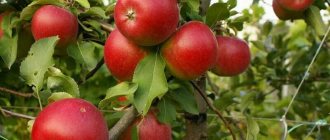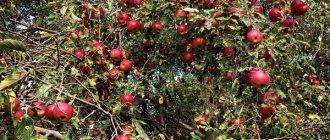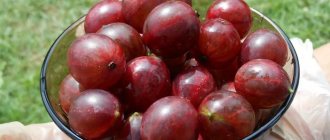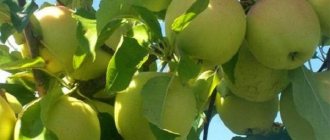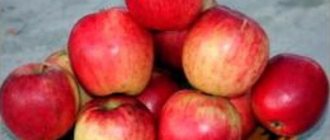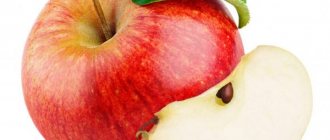Characteristics of the variety
The Imant apple tree is a winter tree, and even with a late ripening period. The fruit crop is small in size, but very productive. Imant apples are above average in size and have a very distinctive appearance. The outer cover is rich, red-violet. The pulp is pleasant to the taste, sweet, juicy, with sourness and a light aftertaste.
Peculiarities
A number of positive features make Imant so popular and in demand. Description of the Imant apple tree variety:
- early start of fruiting;
- annual large harvest;
- long shelf life and possibility of transportation;
- resistance to low temperatures;
- unpretentiousness;
- gene for absolute resistance to scab.
At the same time, there are no disadvantages of the variety.
Tree height
Under normal conditions, the apple tree grows up to three meters. But the Imant apple variety can be smaller if planted on a dwarf rootstock.
Crown width
The crown corresponds to an apple tree: it is small, neat, and sparse. Due to this, Imant is often used in industrial plantings. A distance of three meters between apple trees is enough so that they have enough space and light.
Productivity
The apple tree is small, but every autumn it is completely covered with large fruits. Typically, the weight of the harvest from one tree reaches 30-35 kg.
Tasting assessment
On the tasting scale, the apples received a rating of 4.2 out of 5. But this figure is subjective, because a decent percentage is removed for the lack of aroma. Although this indicator is not for everybody.
Winter hardiness
Resistance to low temperatures is very high. Imant is even grown in the harshest Siberian regions.
Apple tree in winter.
Disease resistance
Genetically, the variety is immune to diseases and does not suffer from scab at all, even during epidemic years. Good immunity allows the variety not to suffer from other common diseases.
Lifespan of a tree
An apple tree can be cultivated on a dwarf rootstock, then its lifespan is noticeably shorter. But it is also possible to grow on a vigorous rootstock, then it can grow up to 35 years.
Fruit collection
The fruits need to be collected at the end of September - beginning of October. The main signs of harvest time:
- The fruit comes off the branch without effort. If it holds well on the branch, then you need to wait a little while harvesting.
- You can harvest when the first carrion appears (healthy fruits that have fallen to the ground).
- An apple is considered ripe if, after applying iodine solution to the pulp, it remains white.
- Good indicators of fruit readiness for harvesting are changes in skin color and the presence of marks when pressed.
- The fruits can be harvested if brown seeds appear when cut.
Apples must be removed from the branches carefully and not allowed to fall to the ground. The stalk should be torn off in a circular motion. Rotten and damaged fruits are immediately put aside. Since the Imant apple variety is a late-winter variety, it is best to start harvesting the fruits on the eve of frost.
The fruits are collected in the daytime, when they are warm enough. During collection, you do not need to touch the fruits, because even with slight impact the delicate peel can be damaged. This negatively affects the keeping quality of apples. The fruits are removed exclusively by hand.
Fruits should only be stored with the skin intact and not damaged by insects. They are laid out in boxes or boxes and placed in a cellar with good ventilation. The layers are sprinkled with sand and sawdust. The optimal storage temperature is slightly above 0°C.
In late autumn, you need to clear the area around the trunk and fill it with peat or humus. You need to form a small mound of earth near the trunk. The trunk needs whitewashing. Copper sulfate and powdered clay are added to the lime solution (quicklime). This whitewash effectively protects the tree from pests.
On a note! The barrel is wrapped in burlap or any material that allows air to pass through well. When snow falls, a snowdrift about 50 cm high forms around the apple tree.
Planting and care
The apple tree is considered unpretentious. But in order to lay a good foundation for full development and fruiting, it needs to be planted correctly.
Landing dates
It is necessary to focus more not on the exact date, but on weather conditions. If this happens in the spring, it is usually at the end of April or beginning of May. The timing should be when the earth has already warmed up well, but the foliage has not yet appeared.
When planting in autumn, the procedure is carried out after the leaves have fallen, but at least a month before frost.
Technology
Selecting seedlings is a very important process. Their height should reach about 120 cm, preferably two years old. The roots should be alive, fresh and fairly dense. If possible, it is better to buy seedlings with a closed root system.
Apple tree planting diagram.
You need to choose a place that is sunny, protected from the wind and away from groundwater. The soil must be fertile, but its structure can be improved. Prepare a planting hole of sufficient size in advance; it is important to place useful substances inside.
Planting is carried out using familiar technology:
- a mound of fertile soil is poured into the hole;
- the seedling is placed and the roots are straightened;
- sprinkle with soil so that there are no voids;
- well watered.
After planting, you need to make sure that the neck of the root is not deepened. After the soil has settled, it needs to be replenished and mulched.
The distance between plantings can be left very small: about 3-4 meters in the rows and between them.
Growing
Although the variety is not demanding, it responds very well to fertilizing. You just need to apply fertilizers correctly, in the right quantities, and start two years after planting.
Preparing for winter
The apple tree is very resistant to low temperatures. She winters well in any conditions. The roots of the variety on dwarf rootstocks need to be insulated, because they are close to the soil surface. During the winter, the tree trunk circle and crown should be covered with snow as much as possible.
Preparing the apple tree for winter.
The trunks need to be prepared correctly. Rodents love to feast on young, juicy shoots, but since they cannot reach them, they gnaw on the young bark. It needs to be wrapped with roofing felt and covered with spruce branches. Spruce branches are not the most convenient place for wintering voles and other insects.
Agricultural technology
Proper planting is the first step to growing healthy apple trees. Second, but no less important, is the appropriate agricultural technology:
- regular watering 3-4 times per season, but adjusted for the weather;
- mulching the tree trunk circle;
- fertilizers for the roots and leaves;
- pest protection;
- cleaning the tree trunk circle and keeping it clean throughout the season.
Pruning and crown formation
The crown responds very well to formative pruning. Moreover, you can give it traditional forms or some original ones. All cuts must be made carefully, with a clean tool, and heavy cuts must be covered with garden varnish. The side branches need to be shortened by a third and those that stretch upward after the apple tree reaches five years of age.
Damaged parts must also be removed by performing sanitary pruning. It is important to cut off all shoots that grow inward, thicken the crown and interfere with the skeletal branches. Those damaged by the wind, broken or damaged by pests also need to be cut off.
Apple tree pruning diagram.
Pollinator varieties
The Imant apple tree variety needs pollinators for the full appearance of ovaries. It doesn’t matter what variety is planted, the main thing is that it blooms at the same time.
Sapling Imant
Although the apple tree is indifferent to the planting site, in order for it to produce good harvests, the land must first be prepared. Like any young seedlings, this apple variety also needs a large amount of natural vitamins, minerals and other macro- and microelements. Of course, individual types of fertilizer can burn the root system, and the apple tree will simply disappear.
How to properly plant an Imant seedling?
- First you need to prepare a hole for planting. It should have a width of 60 cm, the same length, but its depth should be 80 cm.
- At the bottom of the prepared hole (pit) we pour natural fertilizer, which can be fluorine, ash or dry horse humus.
- Next, this fertilizer is covered with a small layer of soil and thoroughly filled with water.
- After the water has been absorbed, a layer of washed sand is added, with the help of which the apple tree can freely take water and useful compounds from the soil.
- Next, we pour a small sand mound in the center of the hole, on which the root system of the tree will be installed.
- The last thing is to fill the seedling with loose soil so that the root queen sticks out of the ground by 7-8 centimeters.
The tree does not tolerate shade, and if you want to get large and juicy fruits, it is better to plant it in an open area where the seedling is provided with constant access to sunlight.
If you do it strictly according to the instructions, then your Imant apple tree will delight you with the juicy and large fruits that we are so used to seeing in photos in glossy gardening magazines. By the way, it is better to plant in late winter, then the plant quickly adapts to weather conditions.
Features of ripening and fruiting
Imant is a typical winter-ripening variety that bears fruit on time and annually.
Beginning of fruiting
On dwarf rootstocks, the apple tree produces its first fruits already from the second year of life. Of course, you will need to wait a few more years for the fruiting to become plentiful, but trying the apples is enough.
The first fruits on the seed rootstock will have to wait another year. The first fruits can be collected in the third year. Abundant fruiting usually begins on the fourth or fifth.
Flowering period
The apple tree blooms in the second half of May, quite late. But the flowering is abundant and lasts about two weeks.
Apple tree blossom.
Removable fruit maturity
Usually fruits are ready for harvesting at the end of September. But you need to focus on the climatic features and climate of the region. You should focus on the condition of the fruit.
Storage and harvest periods
Apples have thick skin, so they can be transported without loss over any distance if they are packed in boxes.
The shelf life is amazing, it is a pride and a feature. They can remain in cellars until April without losing their taste. And they can be kept in refrigerators until the next harvest.
Briefly about the main thing
- Imant is a variety of apples native to Belarus. It was developed relatively recently, about 20 years ago, but has gained a reputation as a promising crop. Suitable for growing in warm or average climate regions of the CIS countries.
- Suitable for both industrial and home cultivation. It has average frost resistance and very good disease resistance.
- The variety is easy to care for, but it requires regular and abundant watering.
- The fruits taste very good; according to reviews, they are unusually tender. In addition, Imant apples will fall in their color - their skin is purple, very beautiful and eye-catching.
- Apples last for several months and withstand transportation well. Moreover, the longer they are stored, the sweeter they become.
Subspecies and options
Imant can be grown on seed rootstock. But there are also possible subspecies.
Dwarf
The Imant apple tree on a dwarf rootstock is even smaller and more compact. Convenient sizes mean an earlier start of fruiting, but the same amount of harvest.
The photo shows the Imant variety on a dwarf rootstock.
Clone
Work on creating a clone of Imant is still underway, breeders are working hard.
Requirements for apple trees
There are hundreds of varieties of apple trees. But breeders continue to work on creating new ones. What qualities do they want to achieve? Why are they not satisfied with the existing varieties?
In recent years, the climate has changed noticeably. Various viral infections that affected fruit trees before have now become significantly more active. Therefore, gardeners give preference to varieties that are resistant to diseases. This allows you to avoid spending additional effort fighting them. After all, these are extra material costs and troubles. As a result of the frequent use of chemicals that are usually used to combat diseases, it is not possible to talk about the environmental friendliness of products. Sometimes frequent treatments cannot be carried out, and trees or crops are lost.
When choosing a variety, great importance should be paid to the keeping quality of the fruit. This is especially true for winter and late winter varieties.
Growing in different regions
The rules for caring for an apple tree are almost identical in any region. There are only some minor differences.
In outskirts of Moscow
There are no restrictions on growing apple trees in the Moscow region, either to the north or to the south. Good immunity allows planting here without problems.
In the Urals
The variety is quite young and there is little information on its cultivation in different regions. But all indicators and varietal characteristics indicate that cultivation is quite possible.
In Belarus
Rains and frosts are eternal companions of the Belarusian climate. But the Imant variety can easily tolerate all this. Even in not the most favorable conditions, the apple tree bears fruit and easily endures the vagaries of nature.
Reviews
Nadezhda, 30 years old, Ukraine: “Although I don’t like experiments, I read so many good things that I couldn’t resist and bought a seedling. I'm very pleased. The apple tree is small, but completely covered with fruit. Fruits in any conditions."
Victor, 48 years old, Moscow region: “We bought a two-year-old apple tree seedling just at the market. We thought it wouldn't grow like that. But the apple tree began to grow easily and quickly. There are no problems with her at all, she doesn’t get cold or get sick. But the taste of the fruits cannot be conveyed; it’s a pity that they don’t smell.”
Description of plants
The Imant variety is the fruit of long work by Belarusian scientists. It will be obtained by mixing the Liberty and Albrey varieties, which are very good in themselves. The first trees were bred in 1999, but for several more years the variety was tested and tested. As a result, it entered the open market only in 2005 - after being included in the register of plants recommended for cultivation in the Russian Federation.
I’ll say right away that any varieties that were bred in the CIS are good for the CIS. They are accustomed to our climate, they adapt easily and do not need additional adaptation like varieties from more distant countries. Therefore, I strongly recommend that beginning gardeners choose these varieties.
Imant is an excellent tree for a summer cottage or a private house. The plants themselves are small - low trees, with a small crown of a pleasant round shape.
